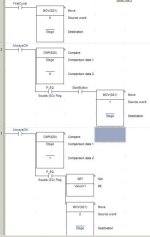Shosh
Member
I was wondering how an automation professional creates a ladder diagram from given specs?
Is there a good organized method you use?
Is there a good organized method you use?

If Stage=0 and Start.pressed -> Stage=1
If stage=1 -> set V1.Open -> Stage=2
If stage=2 and V1.Opened -> Stage=3
(option: Is Stage=2 and timer.max elapsed -> Alarm "V1 blocked" and stage=0)
If stage=3 and Weight=250kg -> set V1.close -> Stage=4
Is stage=4 and V1.Closed -> set MixerBlade -> Stage=5
etc.....
Basically it is, but there are several more steps. One big one is to identify all of the things (alarm conditions) that you DON't want to happen at each step, and create alarms for those. Also, you have to work with others to identify interlock conditions that you should use to prevent your program from advancing to the next Step, or operating when some other condition in the plant should prevent it from doing so.Is this what you usually do in industry?
